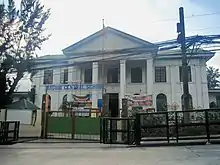Mateo Cariño | |
|---|---|
 Mateo Cariño monument at Rizal Park, Manila | |
| Born | 1841[1] |
| Died | June 6, 1908 (aged 66–67) |
| Occupation | Chieftain |
| Known for |
|
Mateo Cariño was an Ibaloi chieftain[2] who owned the land that was to become Baguio. He led a successful revolt against the Spanish garrison in La Trinidad and was proclaimed the Capitan Municipal of Baguio by President Emilio Aguinaldo.
Background

Cariño owned vast tracts of land which covered the area which would later be known as Baguio as early as the Spanish colonial period.[3] Titles over the land were given to him by the Spanish colonial government in exchange for his conversion to Christianity. His surname was adopted after his conversion.[2] The land was a rancheria known as Kafagway and was the residence of the Cariño clan and the rest of the Ibaloi community.[4]
In 1901, Cariño was selected as representative of Baguio to chief executive of the US Insular Government over the Philippines.[4]
Cariño reportedly gave Emilio Aguinaldo, President of the Revolutionary Government of the Philippines who was fleeing to Hong Kong, refuge. This is said to have caused the American colonial authorities who took over the Philippines to issue military decrees that mandated the confiscation of Cariño's lands. Cariño involved himself in a legal dispute seeking for the voiding of the decrees until his death in 1908. He had a favorable posthumous legal victory when in February 1909 the US Supreme Court, through Justice Oliver Wendell Holmes, recognized his "native title" over his lands which was established through testimonies that the land was utilized, owned, and occupied by indigenous populations.[2][5][6]
Legacy

The landmark case where Cariño had a legal victory—Cariño v. Insular Government, 212 U.S. 449 (1909)[5]—would later be known as the "Mateo Cariño Doctrine" ("Cariño Doctrine", or "Native Title") which forms the legal basis of the protection of indigenous rights over ancestral lands,[7][2] including in the 1987 Constitution of the Philippines.[6] The case is also the legal basis of the Indigenous Peoples' Rights Act of 1997 (IPRA).[6]
On August 16, 2010, the city council of Baguio passed a resolution which allotted an vacant area at Burnham Park to a monument honoring Cariño and the Ibaloi people.[4]
Personal life
Mateo Cariño was married to Bayosa Ortega with whom he had nine children.[2] Bayosa was the only daughter of Enrique Ortega, and the granddaughter of Apulog Minse, both baknangs. Bayosa owned large tracts of land in Kafagway, bought from her ancestors wealth based on gold and cattle trading. Mateo's father was Mawmaw. Mateo expanded the gold trade, introduced rice cultivation and large-scale livestock trading to become the richest baknang. Mateo's older brother was Juan Cariño Oraá, who became the deputy governor of Benguet, then a subprovince of Mountain Province.[8][9]
References
- 1 2 Cojuangco, Tingting (June 13, 2004). "A tale of two women". The Philippine Star. Retrieved October 13, 2018.
Cecile's most illustrious ancestor is Mateo Cariño, her grandfather who was an Igorot chief born in Tublay, Benguet in 1841.
- 1 2 3 4 5 Ronda, Rainier Allan (February 12, 2010). "Ibaloi chieftain's descendants assail NCIP land award". The Philippine Star. Archived from the original on October 23, 2017. Retrieved October 22, 2017.
- ↑ Boquiren, Rowena Reyes (August 23, 2015). "Baguio's history and cultural heritage". Northern Dispatch Weekly. Archived from the original on April 1, 2019. Retrieved October 13, 2018.
- 1 2 3 Castro, Leia (August 29, 2010). "Mateo Cariño monument to rise in Burnham Park". Baguio Midland Courier. Archived from the original on October 14, 2018. Retrieved October 22, 2017.
- 1 2 "MATEO CARINO, Plff. in Err., v. INSULAR GOVERNMENT OF THE PHILIPPINE ISLANDS". Legal Information Institute. Cornell Law School. Archived from the original on July 24, 2021. Retrieved December 13, 2023.
- 1 2 3 Cabreza, Vincent (November 30, 2023). "Monument to 'Native Title' hero to rise at Burnham Park". Philippine Daily Inquirer. Archived from the original on November 29, 2023. Retrieved December 13, 2023.
- ↑ "Molintas wants NCIP to look at revised city charter". Baguio Chronicle. November 21, 2022. Archived from the original on December 6, 2022. Retrieved December 13, 2023.
The Mateo Carino Doctrine was a Supreme Court ruling penned by Chief Justice Oliver Wendell Holmes. It has benefited not only the IPs of the Philippines but also the native communities in the other parts of the world as courts around the globe continue to cite this jurisprudence in protecting the rights of the original inhabitants of a certain territory.
- ↑ Habana, Olivia M. (2000). "Gold Mining in Benguet to 1898" (PDF). Philippine Studies. 48: 483–484. Retrieved October 13, 2018.
- ↑ "Former Governors". Province of Benguet. Retrieved June 22, 2023.